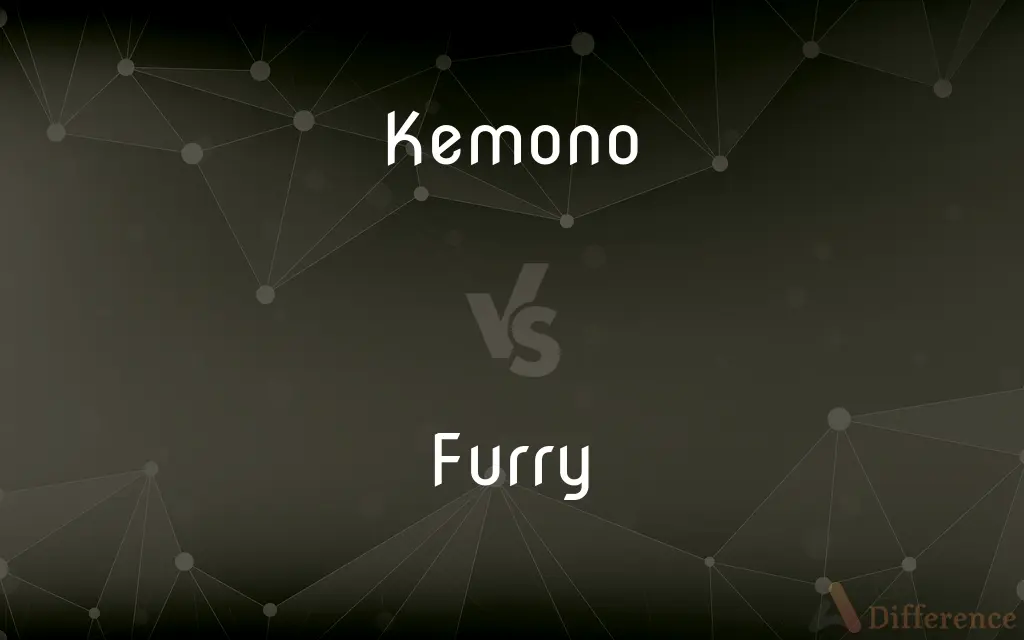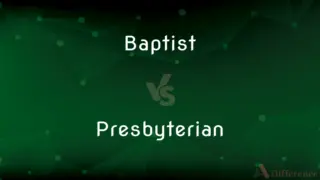Kemono vs. Furry — What's the Difference?
Edited by Tayyaba Rehman — By Maham Liaqat — Updated on March 25, 2024
Kemono focuses on animal characters with a distinct Japanese cultural and artistic style, whereas Furries are a broader Western-centric fandom embracing anthropomorphic animal characters.

Difference Between Kemono and Furry
Table of Contents
ADVERTISEMENT
Key Differences
Kemono art and culture originate from Japan, emphasizing characters that blend human and animal features in a style often associated with anime and manga. These characters are integral to a variety of media, including video games, animations, and comics. Kemono aesthetics tend to highlight cuteness and a distinctive Japanese artistic flavor. On the other hand, the Furry fandom is rooted in Western culture, encompassing a wide range of activities, artistic expressions, and conventions celebrating anthropomorphic animal characters. Furries not only enjoy art and media featuring these characters but also engage in creating costumes, or "fursuits," and participate in communities and events that celebrate their shared interests.
While Kemono characters are typically designed with a specific set of stylistic norms that align with Japanese animation and comic styles, including larger eyes and more exaggerated expressions, Furry characters can vary widely in design, from cartoonish to realistic. This reflects the diverse influences and preferences within the Furry community, which draws from a broad spectrum of Western animation, comics, and fantasy literature.
The Kemono community in Japan is relatively niche and centered around specific genres of entertainment and art, with fans often participating through online communities, conventions, and fan-produced works. Whereas, the Furry community has a more extensive international presence, with large conventions held around the world, a strong online presence, and a wide-reaching cultural impact that extends into mainstream media and public consciousness.
Another key difference lies in the way these communities interact with their respective cultures. Kemono fans may focus more on consuming and creating media within a defined aesthetic scope, while Furries often emphasize community involvement, personal identity expression through character creation ("fursonas"), and a diverse range of artistic creation from literature to visual arts and performance.
Despite these differences, both Kemono and Furry communities share a common appreciation for anthropomorphic animal characters and often overlap in terms of fan interests and cross-cultural exchanges. Fans from both sides may enjoy works from the other tradition, highlighting the universal appeal of anthropomorphic characters across different cultures.
ADVERTISEMENT
Comparison Chart
Origin
Japan
Western (primarily USA and Europe)
Style
Anime and manga-inspired, emphasizes cuteness
Diverse, ranges from cartoonish to realistic
Community Focus
Consuming and creating media, online communities
Community involvement, conventions, creating and wearing fursuits
Cultural Influence
Niche, focused on Japanese entertainment
Broad, with international presence and influence
Character Design
Larger eyes, exaggerated expressions, often sleek
Varies widely, influenced by a broad spectrum of Western art
Compare with Definitions
Kemono
Anime-Inspired Animal Characters.
Kemono characters often feature large, expressive eyes and vibrant colors, reminiscent of anime styles.
Furry
Anthropomorphic Animal Fans.
Furries enjoy creating and engaging with characters that possess human and animal traits.
Kemono
Focused on Media Consumption.
Fans of Kemono typically engage with video games, comics, and animations featuring these characters.
Furry
Community and Identity.
Many Furries create fursonas as a form of self-expression and identity within the community.
Kemono
Distinct Aesthetic Style.
Kemono characters are known for their unique blend of cuteness and anthropomorphism, setting them apart visually.
Furry
Diverse Artistic Expression.
The Furry community produces a wide range of art, from digital illustrations to elaborate costumes.
Kemono
Niche Fandom.
The Kemono community, while passionate, is considered more niche than its Western counterparts.
Furry
Wide Cultural Impact.
The Furry community influences and participates in mainstream culture through conventions and online content.
Kemono
Japanese Cultural Influence.
Kemono art includes traditional Japanese elements, blending them with anthropomorphic animal designs.
Furry
International Community.
The Furry fandom has a significant global presence, with members from various countries.
Kemono
Kemono (ケモノ, derived from kemono (獣) "beast") may refer to:
Furry
Consisting of or similar to fur.
Furry
Covered with, wearing, or trimmed with fur.
Furry
Covered with a furlike substance.
Furry
Having a furlike quality, as in tone; fuzzy
A furry voice.
Furry
Covered with fur, or with something resembling fur.
His treatment of our furry friends was nothing short of appalling.
Furry
(informal) Of or related to the furry subculture.
Furry
An animal character with human-like characteristics; most commonly refers to such characters created by members of the furry subculture.
What percentage of furries are wolves?
Furry
A member of the furry fandom.
The furry had designed an elaborate costume.
Furry
Someone who roleplays or identifies with a furry character. (Compare therianthrope.)
Furry
Covered with fur; dressed in fur.
Furry
Consisting of fur; as, furry spoils.
Furry
Resembling fur.
Furry
Covered with a dense coat of fine silky hairs;
Furred animals
A furry teddy bear
Common Curiosities
What is a Furry?
A Furry is a person who has an interest in anthropomorphic animal characters, often participating in a community that creates and enjoys art, costumes, and conventions centered around these characters.
Are Kemono and Furries related?
While they focus on similar themes of anthropomorphic animals, they stem from different cultural backgrounds and have distinct community focuses and artistic styles.
What is Kemono?
Kemono refers to a Japanese style of art and culture focusing on anthropomorphic animal characters, often found in anime and manga.
What's the significance of a "fursona"?
A "fursona" is a persona that Furries create, representing themselves as anthropomorphic animal characters, often reflecting their personality, preferences, or idealized selves.
Can someone be a fan of both Kemono and Furry?
Yes, individuals can enjoy and participate in both Kemono and Furry cultures, as there is often overlap in interests and appreciation for anthropomorphic animal characters.
Is Kemono more popular in Japan?
Yes, Kemono is primarily a Japanese phenomenon and is more niche and localized compared to the globally spread Furry community.
How do Kemono and Furry styles differ?
Kemono styles are heavily influenced by anime and manga, featuring characters with large eyes and exaggerated expressions, while Furry styles can range from cartoonish to realistic, reflecting a broader diversity.
Do Furries have their own conventions?
Yes, the Furry community hosts numerous international conventions that feature art, workshops, and social events.
What are some common activities in the Furry community?
Furries often create art, write stories, make and wear costumes (fursuits), and attend conventions and meet-ups.
How does the art creation process differ between Kemono and Furry artists?
While the process can be similar, Kemono artists often adhere to a specific aesthetic influenced by anime and manga, whereas Furry artists have a broader range of influences and styles.
Why do people join the Furry community?
People join the Furry community for various reasons, including a love for anthropomorphic characters, a sense of belonging, creative expression, and social interaction.
What activities do Kemono fans engage in?
Kemono fans typically engage in consuming media such as video games, comics, and animations, as well as participating in online communities and conventions.
Are there specific genres of media where Kemono characters are prevalent?
Kemono characters are commonly found in genres like fantasy, adventure, and romance within the realms of video games, animations, and comics.
Can Kemono art be considered a subgenre of anime?
In a broad sense, yes, since it shares stylistic and thematic elements with anime, but it specifically focuses on anthropomorphic animal characters.
Share Your Discovery

Previous Comparison
Endocytosis vs. Phagocytosis
Next Comparison
Baptist vs. PresbyterianAuthor Spotlight
Written by
Maham LiaqatEdited by
Tayyaba RehmanTayyaba Rehman is a distinguished writer, currently serving as a primary contributor to askdifference.com. As a researcher in semantics and etymology, Tayyaba's passion for the complexity of languages and their distinctions has found a perfect home on the platform. Tayyaba delves into the intricacies of language, distinguishing between commonly confused words and phrases, thereby providing clarity for readers worldwide.














































